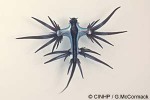Cook Islands Biodiversity Database
Species Page
Glaucus atlanticus
Blue Sea-Lizard
Multimedia & Additional Resources
| Type | Description | Download |
| Adult, Rarotonga | 21KB |
General Information
Cook Islands Distribution
| Southern Group: Present Makatea: | ||||||||
RR |
MG |
AT |
MK |
MT |
AK |
PL |
TK |
MN |
| Northern Group: | |||||
TN |
MH |
RK |
PK |
NS |
SW |
Scientific Taxonomy
Glaucus atlanticus Forster, 1777
SYNONYMS: Glaucus longicirrus; Glaucus marina; Glaucus lineatus
TAXONOMY: ANIMALIA; MOLLUSCA; GASTROPODA; OPISTHOBRANCHIA; Nudibranchia; Aeolidacea; GLAUCIDAE
More Information
GENERAL NOTE: This seaslug is widely described as one of the most beautiful of all sea creatures. It actually creeps along on the underside of the surface-film of the ocean, such that its ventral side is uppermost, and is dark blue for camouflage. It feeds on various floating coelenterates, such as the By-the-wind-sailor (Velella) - its favourite food, Portuguese Men-o'-War (Physalia), and Porpita. They are sometimes washed ashore after storms. The gut has extensions (=cnidosacs) to the end of the cerata in which they accumulate the unexploded stinging-cells (=nematocysts) of their prey. They use these for their own defence.
Vouchers & References
Vouchers:
Rarotonga: Muri, 6/98, 3 live specimens, ID GMcC.
References:
None recorded.
Data Update History (information):
zTX, zB02, zM02, zD02
Web Resources
Citation Information
McCormack, Gerald (2007) Cook Islands Biodiversity Database, Version 2007.2. Cook Islands Natural Heritage Trust, Rarotonga. Online at http://cookislands.bishopmuseum.org. ![]()
Please refer to our use policy.

